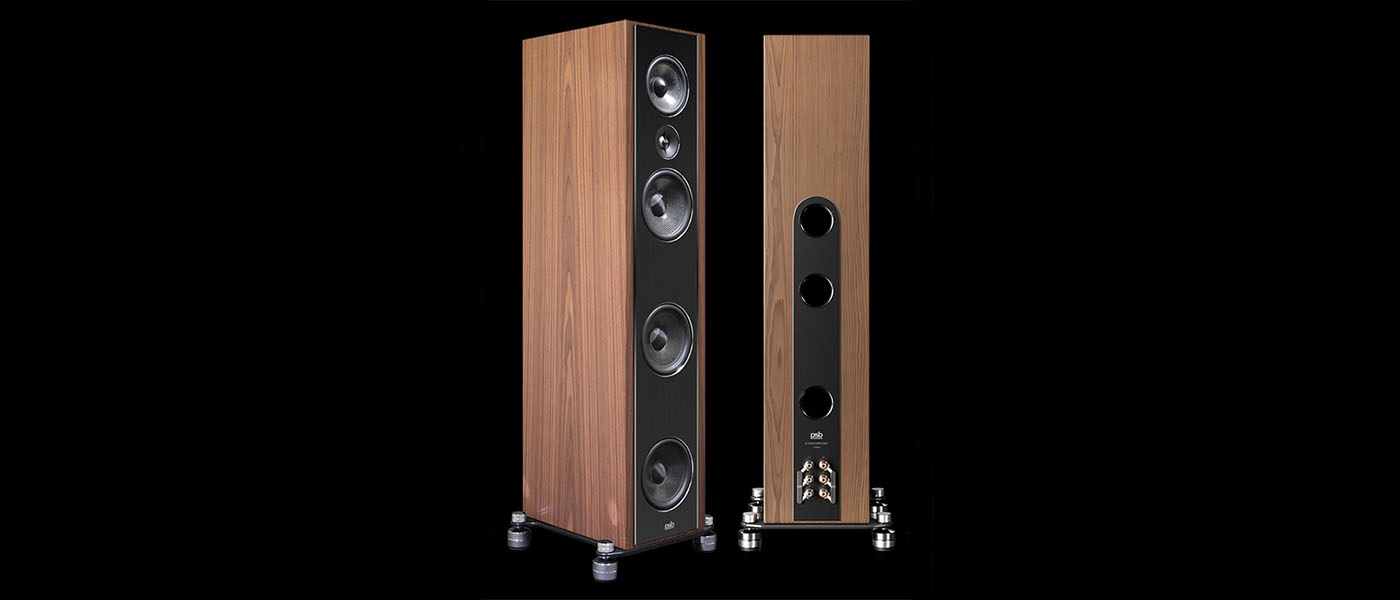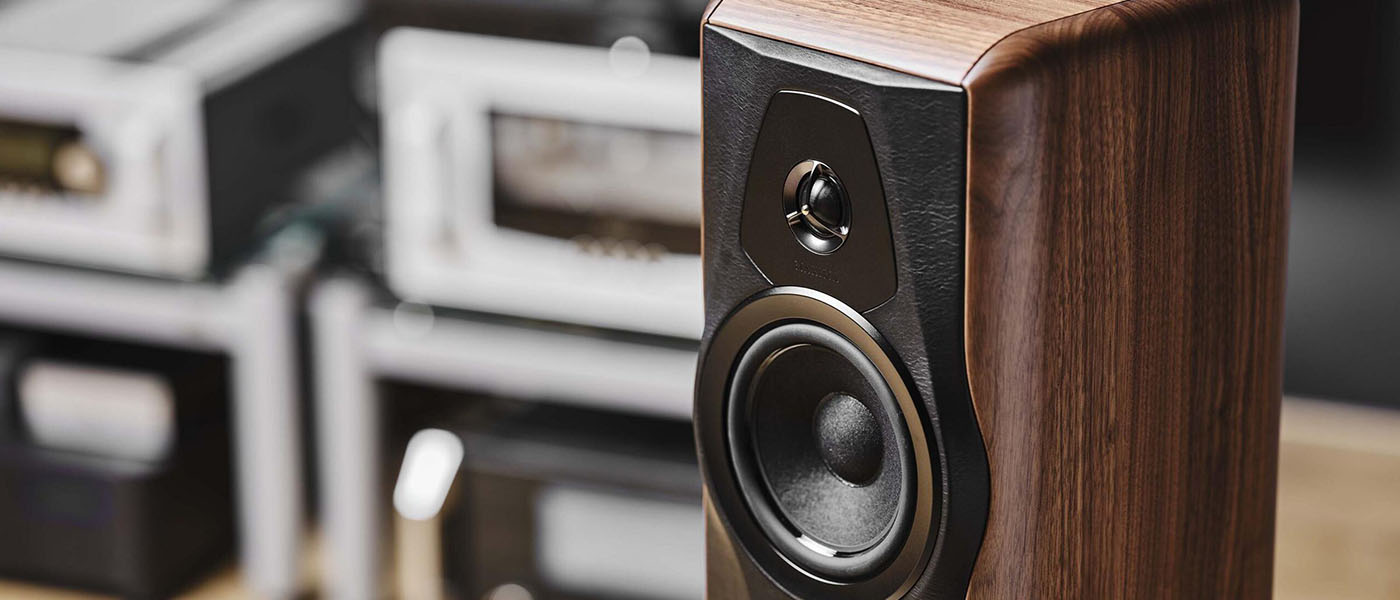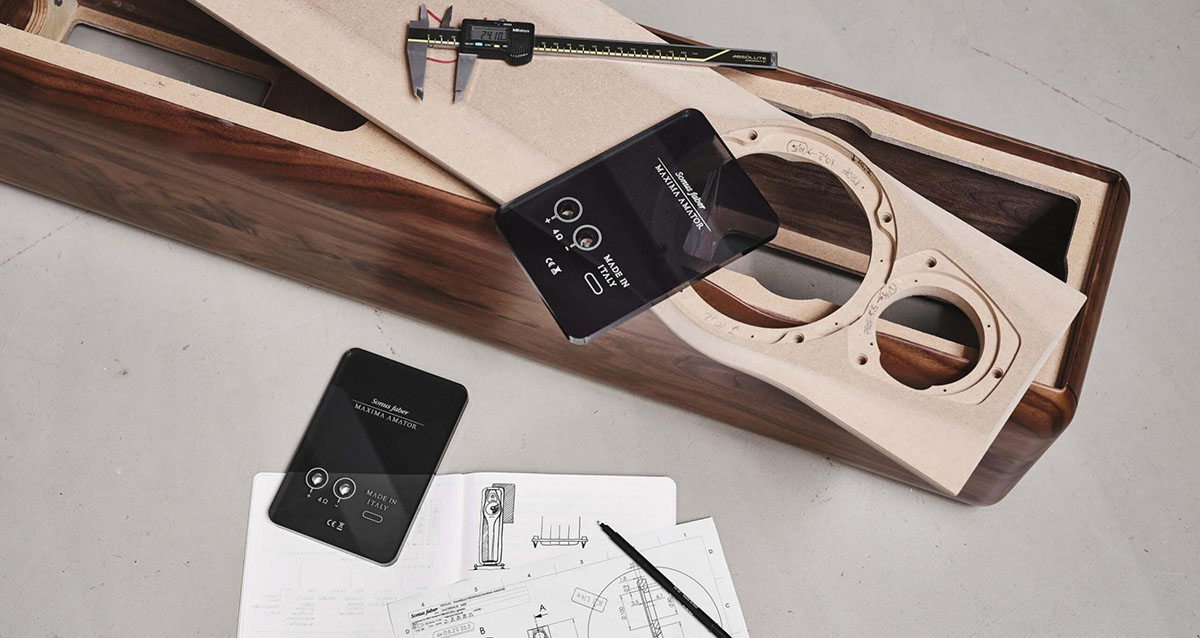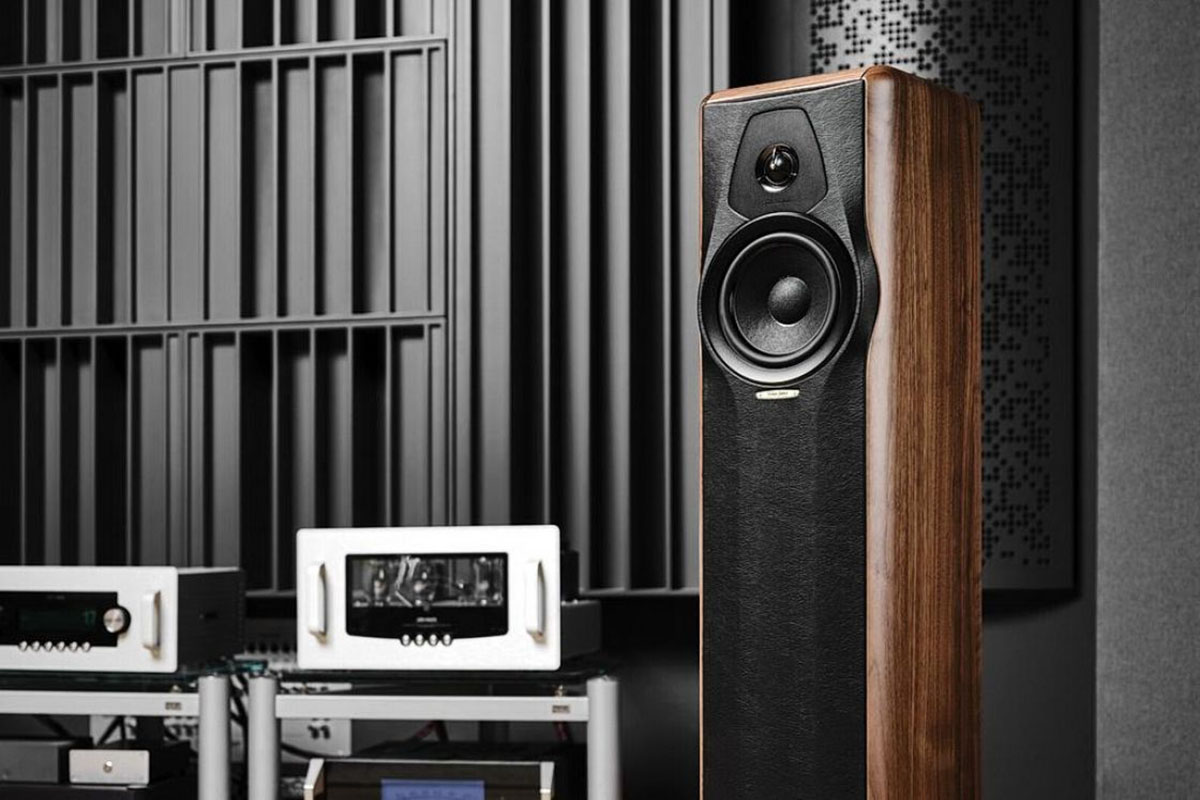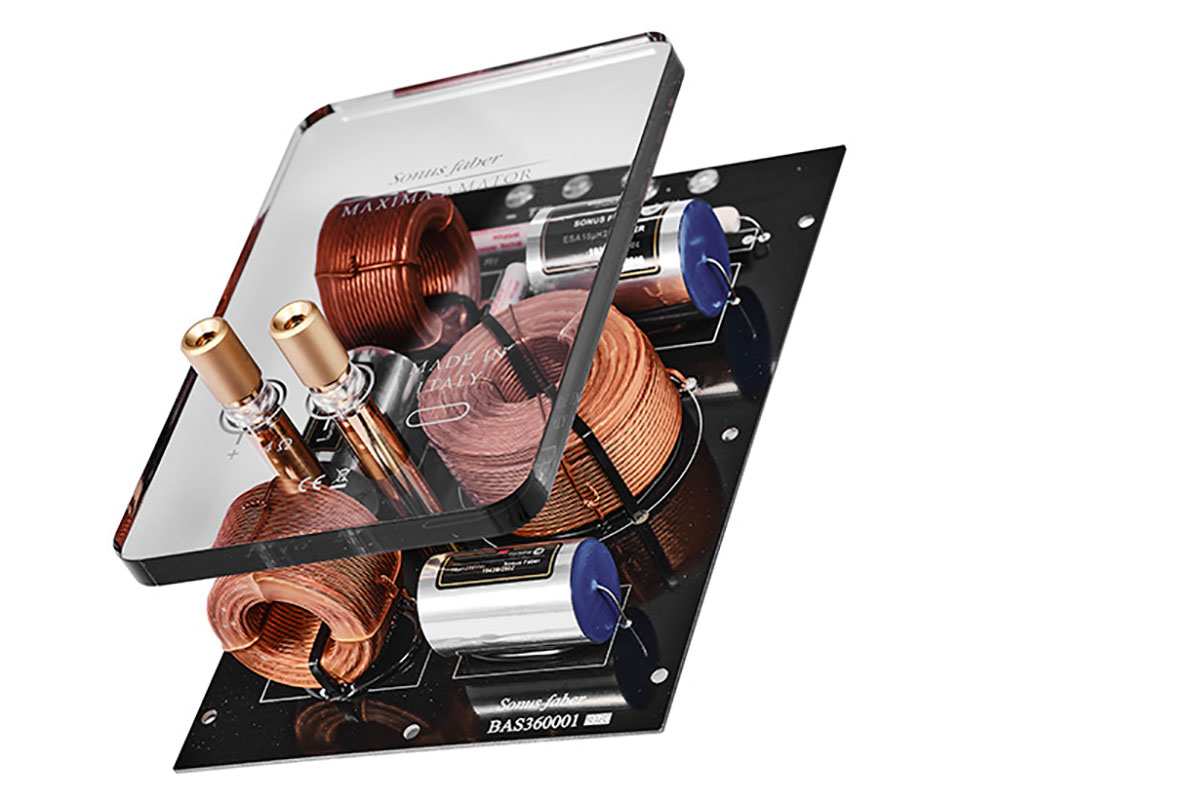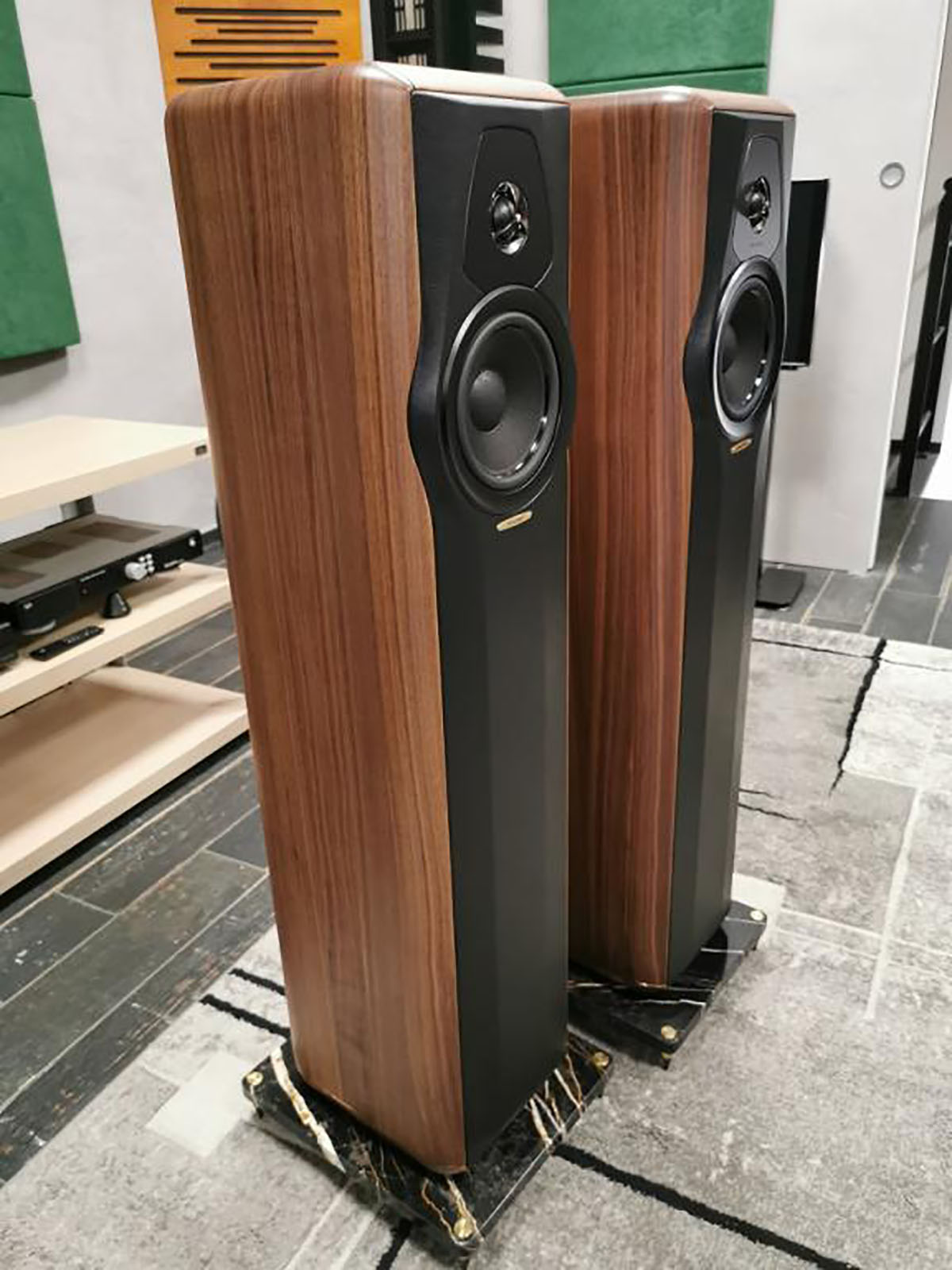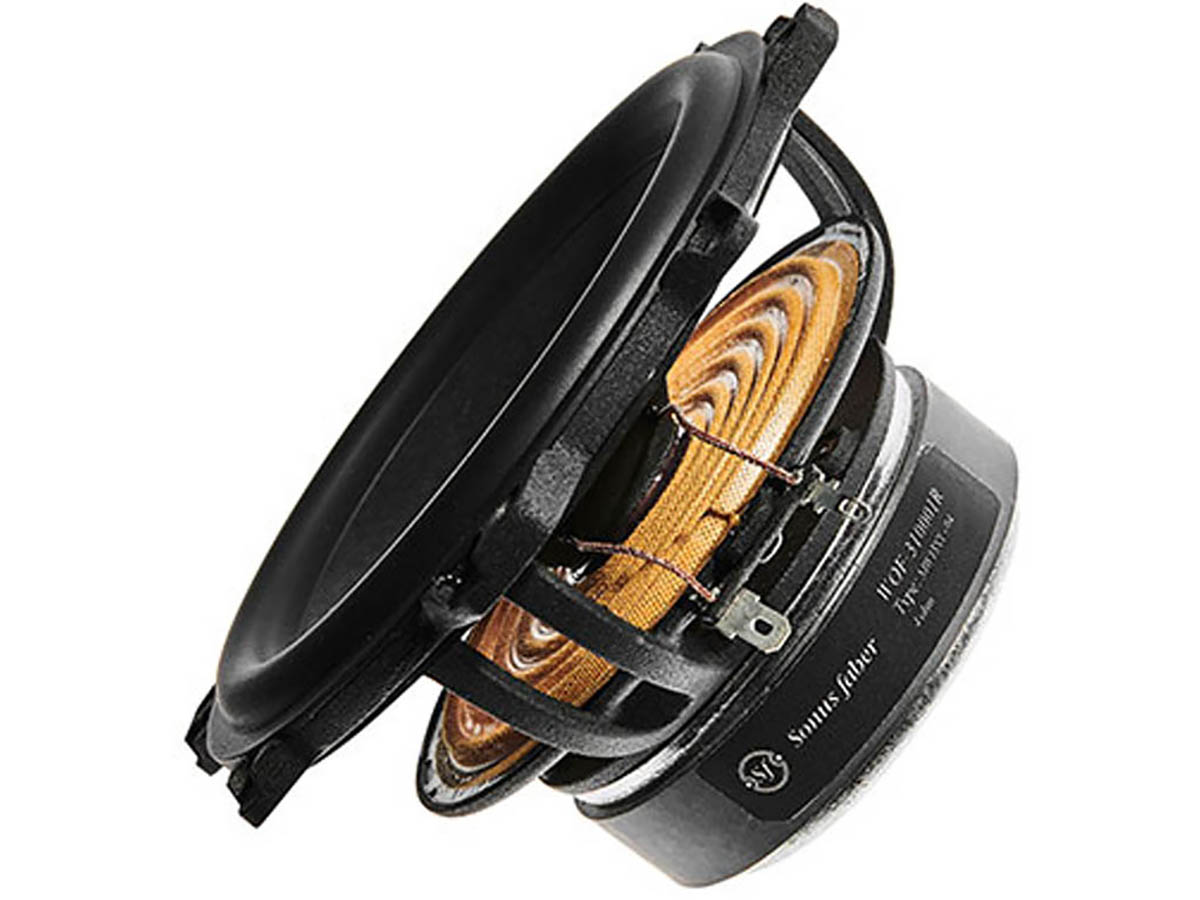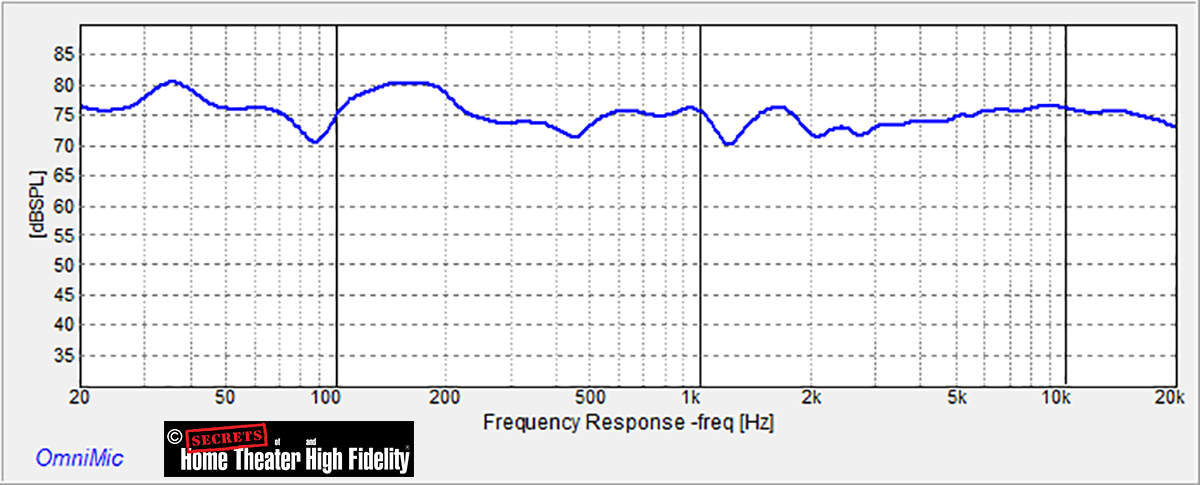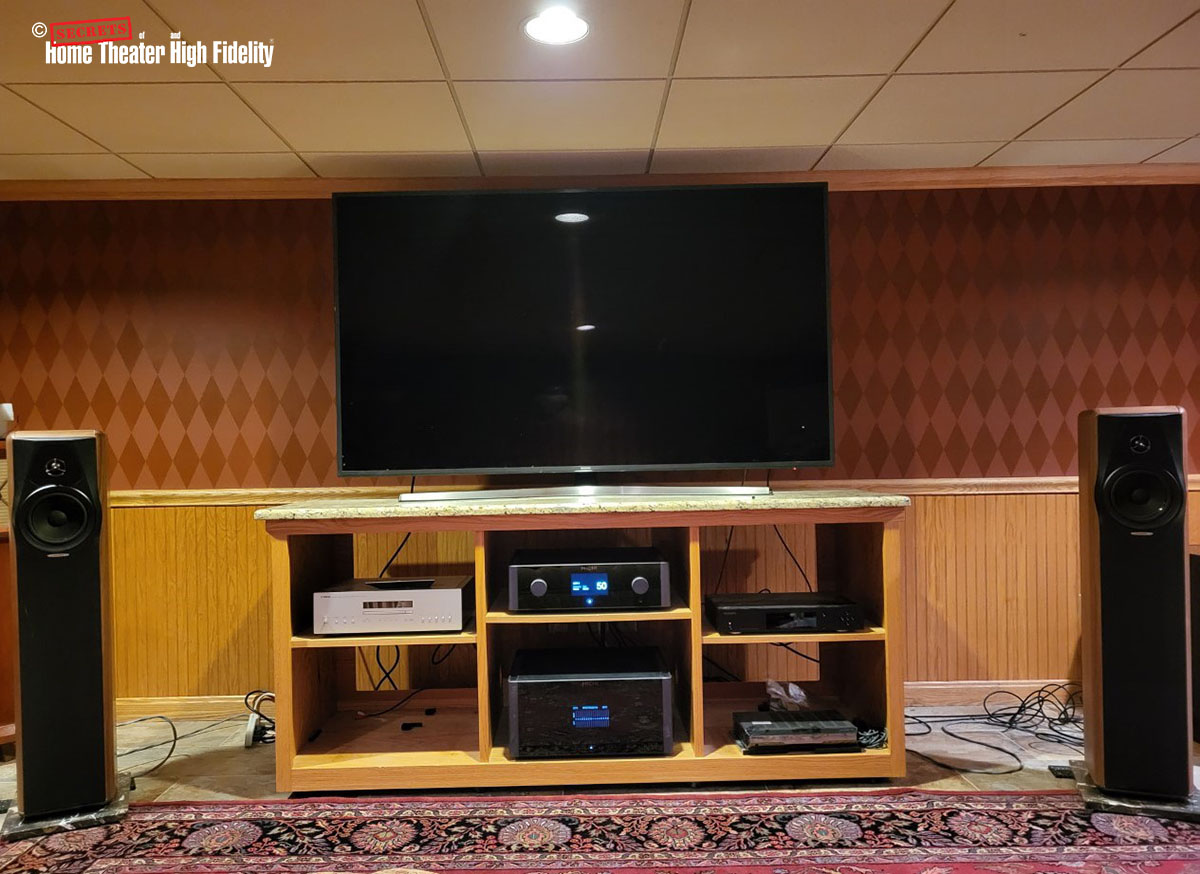The Maxima Amator is the pinnacle of the Heritage line of speakers from Sonus faber. It is a relatively compact tower speaker that pays tribute to Sonus faber’s rich history of making speakers that are so beautiful that owners feature them in a living space rather than hide them. The Sonus faber Maxima Amator speakers are $15,000 per pair, and this review will focus on the sonic performance they deliver.
Sonus faber Maxima Amator Floor Standing Speakers
- Designed and built in Italy
- Solid wood cabinets
- Integrated Port Saint Laurent marble base
- Leather front and rear baffles
- Custom drivers made in-house by Sonus faber™
- Amazing detail without a hint of harshness
- A work of art that makes wonderful music
Sonus faber has, for almost 40 years, built loudspeakers at their factory in Vicenza, Italy that combine beauty with musical finesse. The company has grown to the point that it has over 30 different models of subwoofers and speakers. Some of them are immense weighing over 100 pounds each and featuring multiple drivers. In the company’s beginning, the original designs were elegant, two-way speakers that established the heritage of Sonus faber for the decades to come.
The Maxima Amator is the realization of a dream Sonus faber has had for most of those 40 years: A floor-standing loudspeaker that can handle all but the lowest octave bass while being housed in a true walnut cabinet. This is in keeping with the company’s underlying philosophy of designing loudspeakers more like fine musical instruments. After years of work, the artisans at Sonus faber finally mastered the necessary woodworking protocols to make a natural wood speaker that will actually improve with age.
These are not going to be a person’s first loudspeaker. There is a good chance they will be a last loudspeaker purchase, though. We are going to explore why this is the case, including a projection that these speakers are likely to get better with age. The Maxima Amators (along with their smaller, stand-mounted brothers) are as much hand tuned as they are scientifically designed, and require a lot of audio maturity in order to appreciate what the design team has accomplished with these music makers.
System:
2-way floor-standing vented loudspeaker system
Tweeter:
H28 XTR-04 DAD™ / 28 mm / 1.1 in. / Neodymium magnetic motor system implemented with a solid spruce wood labyrinth rear chamber
Mid/woofer:
MW18XTR-04 / 180 mm / 7 in / air dried membrane made of cellulose pulp and natural fibers. Sonus faber original design, aluminum basket.
Crossover:
2.100 Hz IFF “Interactive Fusion Filtering”
Frequency Response:
35Hz – 35,000Hz
Sensitivity:
88dB SPL (2.83V/1m)
Nominal Impedance:
4 ohms
Suggested Amplifier Power Output:
25 – 125W, without clipping
Finish:
Solid Walnut with Brass Inserts
Dimensions:
1120 x 300 x 350 mm
44.1 x 11.8 x 13.8 inches
Weight:
38 Kg each – net weight
83.7 lb. each – net weight
MSRP:
$15,000 (pair)
Website:
Company:
SECRETS Tags:
sonus faber, maxima amator, tower speaker, floorstanding speaker, full range speaker, Speakers Review 2022
- Sonus Faber Omnia All-In-One Speaker Review
- Sonus Faber Lumina II Speakers
- Sonus Faber Serafino Tradition Loudspeaker Review
Loudspeaker companies don’t make floor-standing speakers out of 100 percent real wood panels for no reason. Real wood will expand, and contract based on temperature and humidity, which causes a variety of performance issues. The team at Sonus faber worked for decades to produce a solid walnut floor standing speaker that would deliver on the promise of “The Voice of Sonus faber.” The challenge was to make this enclosure strong enough to withstand this change in the wood’s nature over a period of decades. The design team finally won out by perfecting a series of internal structural ribs anchored with flexible glues, modern wood drying methods, and extremely tight CNC tolerances that were not possible in decades past. After close inspection of these small towers, one is left with a feeling that trying to duplicate the craftsmanship would take months of labor, and one would still not be able to match the quality of these small towers.
Secrets Sponsor
Once the enclosure was completed, the next step was to include the same D.A.D. (Damped Apex Dome™) 28mm tweeter and 180mm woofer similar to the unit from the mighty Aida loudspeaker. The Aida’s crossover network limits the woofer to frequencies above 200Hz while the Maxima Amator requires this driver to operate to its rated lower limit of 35Hz. The final details are found in the crossover and the interior cabinet design.
Inside the solid wood cabinet are three separate chambers, each with an important function. Chamber one features the proper volume for the speaker to be vented with a tuning frequency of about 40Hz. The port is rear firing, which has the benefit of additional boundary gain in the deep bass and less audible issues at high SPL levels. The second chamber is located at the bottom of the speaker and its ceiling wall is angled to help minimize standing waves. This second chamber, which is about a third of the internal volume of the cabinet, is filled with an inert material that increases stability and lowers internal resonances. Chamber three is a dedicated enclosure for the crossover, with the added benefit of insulating the crossover network from speaker vibrations.
Two other features worth noting are the rear crossover window and the tweeter assembly. Sonus faber is so proud of the crossover, they let you see it without dismantling the speaker. I must admit that, after several listening sessions, I grabbed a flashlight in order to get another look at the craftsmanship that went into this crossover network. Everything about these speakers is artistry. The 28mm tweeter is mounted in its own spruce wood acoustic labyrinth rear chamber. This mini chamber for the tweeter adds to the structural integrity of the tweeter while providing additional isolation from the much larger sine waves produced by the woofer.
The crossover employs Sonus faber’s IFF “Interactive Fusion Filtering.” Final tuning is done by ear. The entire package is mounted on a marble base with brass feet. Add the real leather front and rear baffle, and one is treated to a speaker that one has to see in person to appreciate. Most speakers in this modest-size cabinet weigh less than 25kg / 55 pounds. The Maxima Amators tips the scales at 38kg / 84 pounds. In one’s living space, these Walnut gems exude a level of elegance that one rarely finds in our hobby.
As mentioned earlier, the Maxima Amator loudspeakers come with an integrated marble base. One might think this would require some extra effort to mount the speakers onto this base. It was a pleasant surprise to unbox them and discover that no assembly was required. The standard feet are already installed, and the speakers are mounted on the base at the factory. Spikes are also included at no additional charge. Before any listening tests started, I broke them in for 200 hours. For this, I use the Omni Mic™ system’s test disc. Track one, which consists of a full range pink noise signal, was employed using the repeat function.
Secrets Sponsor
Our primary listening had recently had a makeover. The room is 44 x 14.5 x 7 feet and has been my favorite place to listen to music for 26 years and counting. We just changed the flooring from carpet to ceramic tile with a series of area rugs.
The speakers are positioned 30 inches out from the long wall, and 10 feet apart. Being positioned on the long wall, the side walls are about 8 feet away on one side and 26 feet on the other side. After experimenting with toe in, 10 degrees provided the best overall presentation of music. The speakers are 11 feet from the listening position.
The rest of the system consists of a Yamaha™ CD-2100 CD/SACD player, Rotel™/Michi™ P5 Pre-amp and S-5 Power amp, Blue Jeans Cable’s 10-gauge speaker cable (8-foot runs), and Better Cables Blue Truth ULTRA audiophile Balanced XLR cables. The Michi™ P5 and S5 are also in for review from The McIntosh Group™ (parent company to McIntosh Labs™, Sonus Faber™, Rotel™ / Michi™, and Pro-Ject™). The team at the McIntosh Group™ was confident that the Michi™ pair would be ideal with the Sonus faber™ speakers. I have found this pre-amp and power amp to be such remarkable performers that they are my personal reference for powering any loudspeaker pair. An independent lab report has measured the S5 as delivering 670 watts into an 8-ohm load, 1170 into a 4-ohm load with enough current that into a 2-ohm load, the dynamic power was just shy of 1800 WPC. This amp can deliver all the power from a dedicated 30-amp circuit that the 30-amp circuit can produce. The Michi™ pair retails for $11,300. We have two other pre-amp/power amp packages that will also be part of the test. Cambridge Audio’s Edge NQ™ pre-amp and Edge W™ power amp (100 WPC into an 8-ohm load), are not as powerful as the Michi™ pair, but they are excellent performers on their own. The third amplifier setup is from Akitika. Their PR102 pre-amp and GT-102 power amp are available as a set for about $900 delivered as a kit, or $1200 assembled. The value of these units is a real plus for our hobby. The amp is rated at 50 WPC into an 8-ohm load.
The Maxima Amator is a relatively small tower speaker. With just a single seven-inch woofer and one-inch tweeter, they aren’t as awe-inspiring to look at as are many other speakers in this price range, including other models from Sonus faber. The Olympica Nova V has three 7-inch woofers, a 5.5-inch midrange, and a 28mm tweeter in a larger cabinet for about the same money. This is why we listen with an open mind.
We will be discussing several CDs as this review continues, but let’s talk about the general experience now. The Maxima Amator has an uncanny ability to just disappear. Over the last year, having reviewed several other well-respected speakers, I have grown to value how well it seems to deliver music without being able to pinpoint the speaker’s location. These petite towers do this holographic illusion better than any speaker I have ever heard. They are so involving that I find myself listening to the entire disc instead of one or two reference songs on the disc. I have spent hours forgetting that there is a job to be done here: listening and writing down what is being heard.

Nils Lofgren “Nils Lofgren Band Live”
This disc was brought to my attention a few years ago for one single track, the Bass and Drum intro. This instrumental has deft bass guitar riffs working in tandem with the drummer in a toe tapping, face grinning number that challenges a speaker’s ability to remain transparent and powerful across a wide bandwidth.
This track is the ninth song on disc number two. I normally put this disc on and listen to the first few seconds of “I Don’t Wanna Talk About It” before skipping to track nine. Not this time. This time I was instantly enjoying the guitar intro on track one and the easy presentation from the speakers so much, that I put down the remote and just let the music happen. Nil’s vocals were more in the room than with any speaker I have auditioned, and the percussion was spot on. The speakers themselves were not even there. What we have is a performance starting well left of the system and extending well right. In “Lost a Number,” all the emotion of a man meeting the perfect girl only to find he can’t find her tugs at one’s emotions. I have heard this disc hundreds of times, but this was the first time it made me feel like part of each story, which is what each song is. Another first is the Bass and Drum Intro was no longer the centerpiece of the listening experience. Yes, it was handled with the authority that one does not expect from a two-way speaker anchored with a seven-inch woofer. But the entire disc became an unexpected experience.
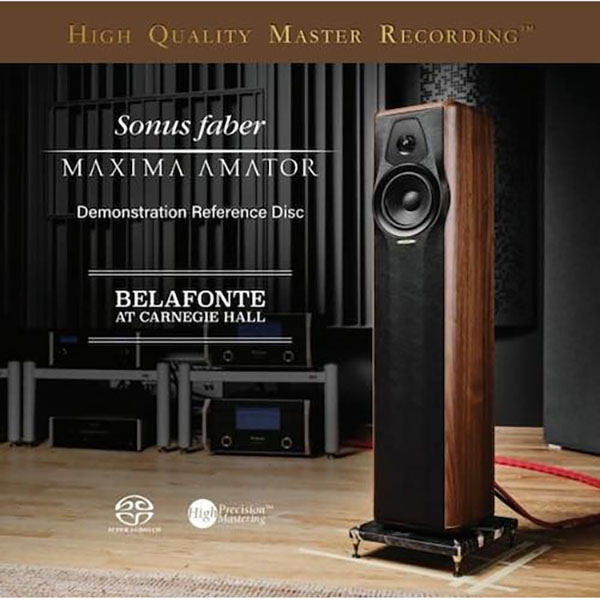
Sonus Faber “Maxima Amator”
Harry Belafonte has always been someone to admire for his singing abilities, and this wonderful disc showcases those abilities with a transparency that is remarkable, especially for a performance from 63 years ago. I originally ordered this disc as part of a reference collection over a year ago. As the Maxima Amator speakers are featured on the SACD’s cover, it was a must-listen with these speakers.
On “Darlin’ Cora,” Belafonte’s voice is rich and pure. Our Co-Editor-In-Chief, Carlo Lo Raso, was able to experience this with us during the review process, and we both came away with an even higher amount of respect for his vocal range. We both agreed it would have been the concert of a lifetime to have Mr. Belafonte and Roy Orbison on stage together. Belafonte would hit close to full tenor notes as a mid-range baritone, demonstrating incredible range. The Maxima Amator was so articulate with Belafonte’s voice that comparisons to some of Quad’s classic speakers came to mind, but with more bass authority and dynamic range. The string bass was authoritative and delicate, and each song had one anxious for the next song. If one wants a disc to demonstrate vocals and an unamplified orchestra, this is a must-have. The Amators were sheer magic on every cut, bringing Mr. Belafonte to life.
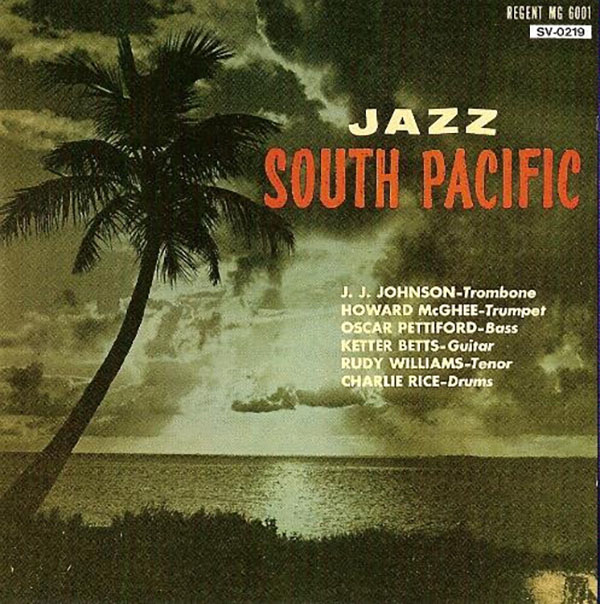
Savoy Jazz “South Pacific Jazz”
This CD is a collection of wonderful jazz, recorded live in 1951 and 1952. Kudos to Denon for taking all these songs and remastering them for our pleasure 70 years later. The disc opens with a deft and lightning-quick kettle drum lead into J.J. Johnson on trombone and Howard McGhee on trumpet. This is an intimate recording that is well suited to the Maxima Amator’s skills with micro dynamics. This first cut, “Royal Garden Blues”, transports one to a summer evening in the early 50s.
You can feel the breeze around you as the musicians take you away into their world. On “Man With The Horn,” Rudy Williams delivers a tenor sax that made me wish I were allowed a cigar and cognac in the house. The audience is loving his style, and the Amators make good on taking you there. One caveat on this disc – microphones of that era were prone to overloading on macro-dynamics, and when they do, the Amators are SO detailed that one hears the distortion. “Body and Soul” is a perfect combination of standup bass, trumpet, and trombone that draws one in with the soothing trombone, then lets one feel the bite of the leading edge of each trumpet note. These speakers can JAZZ!
As this review has progressed, I have become increasingly impressed with the Amators. They have delivered far more clean output and bass than I thought possible for a fairly compact, two-way tower that features a single seven-inch woofer. Pink Floyd’s sonic spectaculars were impressive, as were many of my other rock favorites.

Zach Snyder cut “Justice League”
This brought forth an idea: can they do a full range 2.0 system? This Zach Snyder Blu-ray seemed a perfect disc to test out the big boy abilities of these speakers. In the fight scene right after Superman is resurrected, the percussive bass centers at about 35Hz. These modest size speakers delivered real bass that you can feel in your chest. They also reveal a lot of detail that most speakers miss. The leading end transients are superior to any other speaker we have had here, and dialogue is better than center channel clear. When Lois shows up to calm Superman from wiping out the entire team, the scene goes very quiet, and each breath she takes is heard without effort. In this, and other movies, I found the Maxima Amators to deliver a 2.0 experience that left me wanting for very little. From 30Hz and up, these speakers are nothing short of wonderful.
We don’t have an anechoic chamber in which to measure loudspeakers. This presents a challenge: what is a meaningful measurement to add to a review? Over the last few years, I have used the Omnimic from Dayton Audio and have learned that the measured frequency response and total harmonic distortion at the listening position portray quite nicely not only the abilities of the speaker being tested but also how well the reviewer did in setting the speakers up. In essence, these two graphs show the reader what the reviewer was hearing.
It is not unusual for a speaker that has a +3dB response curve in an anechoic setting to have a +12dB response curve in a real listening room. A lot of work went into our high-end listening room with the goal of being a speaker-friendly environment. We have gotten excellent results from a variety of speakers, and the Maxima Amators was no exception.
From 30 to 20,000Hz, the response curve was within +4dB. This is with no room correction applied. There are speakers that can’t do this well in an anechoic chamber.
In terms of Total Harmonic Distortion, the speakers were measured at 75dB from the listening position, four meters back. At 35Hz, the THD was a low 1.15%. At 50Hz, it was 1.36%. At 100Hz and above, THD was under 0.80%. In listening tests, no compression nor distortion was audible on music with peaks of 105dB. The Maxima Amators won’t deliver 112dB and above as easily as larger speakers with multiple drivers can manage. Within that 105dB range, which is louder than I care to listen to music, they are absolutely a full range speaker.
We had a guest: our Co-Editor-In-Chief, Carlo Lo Raso gives his take:
By: Carlo Lo Raso
I travel to Toronto regularly from my home in Central Ohio to visit family. So, it’s very fortunate for me that Secrets reviewer Craig Chase conveniently lives exactly at the halfway point of my drive. When I heard that he was reviewing a pair of the Sonus faber Maxima Amator loudspeakers, I asked if I might stop in on my upcoming trip to have a listen. Upon arrival, Craig and his family were the most gracious of hosts and we spent much of an afternoon and evening putting the beautiful Sonus fabers through their paces. As Craig has mentioned the speakers were powered by a set of Rotel MICHI P5 and S5 separates, and the speakers were augmented with a Sonus faber Gravis VI subwoofer for good measure. We listened to several different kinds of music both with and without the subwoofer in play. Craig had set things up so that the speakers were being run full range while the subwoofer was low passed to them at 40Hz.
The last time I had heard the Maxima Amators was during my press junket to Sonus faber’s HQ in Italy, in the fall of last year. We were seated in one of the company’s new listening rooms and I got to hear the speakers play in what I considered a perfected listening space, so I knew they were going to sound their best. Craig’s setup is in a well-furnished and comfortable basement space with lower ceilings so (and no offense to the host here) I was mentally prepared for a lesser experience than my Italian listening session. What I got was so completely the opposite of my expectations. The Maxima Amators did indeed sound every bit as memorable as they had in Italy, right here in this basement space. I was more than just a little gobsmacked. Whatever Craig had done with sorting out their placement, the speakers were giving me that same sort of magic with the rendering of vocals and that imaging of instrumentation that I remembered being so impressed with before. And for a two-way mid-tower speaker, the sense of dynamics portrayed by the Maxima Amators was truly remarkable. Craig demoed a Nils Lofgren live track for me (thank God it wasn’t Keith Don’t Go) “Bass and Drum Intro”, a very intense dueling instrumental. The Maxima Amators not only handled the changes of volume and the impact of the cymbals, drums, and electric bass effortlessly, but they also captured all the details in the sounds of said instruments and relayed them convincingly. I will say that I think the MICHI amplification (500 watts @ 8-Ohms and 800 watts @ 4-Ohms) had a bit of a hand in keeping such tight control of things.
Not that the Maxima Amators need a subwoofer, but for me, adding in Sonus faber Gravis VI transformed the speakers from a musical and detailed mid-sized performer to a killer full-range reproduction system of the highest caliber. If I had any issue with the Maxima Amators when I heard them in Italy, it was that while the bass was good, I personally wanted more. Well, this answered that issue in spades. Kudos again to Craig for finding a perfect spot to set up the Gravis because it was just beautifully integrated with speakers, and it gave them an almost transcendent level of authority in that room. I had brought along a USB thumb drive full of some of my favorite demo tracks and one after another it was just a joy to listen to each of them. The added bass foundation was deep, tight, and impactful without sounding bloated or sloppy at all. “Manha de carneval” from the Isao Suzuki Trio had it all with this setup, fantastic musicality, and harmony from this jazz trio but with an “alive” sounding bottom end that made the acoustic bass playing absolutely shine. And fellow Italian, Paolo Conte, singing “Sotto le Stelle del Jazz” on this system was a revelation. Soulful and intimate, it made me feel like I was in a small nightclub listening to him perform. The Gravis VI adds that last little bit of foundational magic to make the illusion complete.
The Sonus faber Maxima Amator loudspeakers and Gravis VI subwoofer can very well be an endgame system for the serious music lover who has the finances to intensively fund their addiction. Not only with the glorious sound quality (when set up correctly) but also that gorgeous build quality and heirloom finishing that Sonus faber is justly known for. Add in those top-shelf MICHI components (or something comparable) and your source of choice and you should be granted one hell of an experience. The Sonus faber Aida’s are a pair of loudspeakers I pine for, hey we all can dream, right? But this system right here does everything so well, sounds so good, and is priced at a comparative fraction of what the Aidas cost, I could die a happy man (metaphorically speaking) if this was my last system. Damn you Craig, and (seriously) thanks for the visit and the opportunity to listen to these in a real environment.
Reviewer’s note – Carlo, thanks for participating! Your experience was a welcome addition to this review!
The SONUS FABER MAXIMA AMATOR TOWER SPEAKERS deliver much of the performance and technology and all of the fit and finish from Sonus faber’s Reference models for $15,000 per pair.
- Fine, detailed, and refined sound
- High-end furniture finish quality
- Imaging that makes them disappear in your room
- Flat frequency response with no audible distortion
- More bass energy below 30Hz
When Julia Lescarbeau from the McIntosh Group asked about testing a pair of high-end Sonus faber speakers, I jumped at the chance, with visions of IL Cremonese coming to mind. The IL Cremonese has four woofers: two 8.7-inch infra-woofers and two seven-inch woofers. They have an MSRP of $55,000. After Julia got me to calm down, she explained that I was going to review a pair of $15,000 speakers with a single seven-inch woofer and a 28mm tweeter that is the same as in the IL Cremonese.
I was certain that this Heritage Speaker called the Maxima Amator would be a quality product with a lot of limits, considering its modest driver setup.
What I found was a pair of speakers that performed at a far higher level than I thought possible for a relatively small tower. There have been so many fun experiences with the Maxima Amators that this could easily have been a 10,000-word review.
The bass is deep and tight. The sound stage is massive. The articulation is pristine without a hint of harshness. These are a very special set of speakers. For a final music selection, I fired up Led Zeppelin II at the end of the review process. The opening song is “Whole Lotta Love.” It’s a 1970 wonder with guitar and special effects in abundance. Those familiar with this song know it has a two-minute section in which the sound pans back and forth and is a headphone listener’s dream experience. The Maxima Amators not only did the back and forth, but the depth of the sound stage was also to the point that some of the effects were from BEHIND the listening position. I played this track for family members, and all remarked about hearing this.
The Sonus faber Maxima Amators are as fine a music maker as I have ever auditioned. On their own, they have made me appreciate music to a new level. The only shortcoming is bass below 30Hz. For $15,000 per pair, these speakers are not only a work of art, but they are also an audio bargain. As for that bass below 30Hz? Carlo Lo Raso mentioned hearing these speakers with the $7,500 Gravis VI. Look for a full review of the Gravis VI this winter. For now, suffice it to say that the Gravis VI subwoofer takes the Maxima Amator from an exceptional $15,000 speaker to a state-of-the-art $22,500 speaker system.


